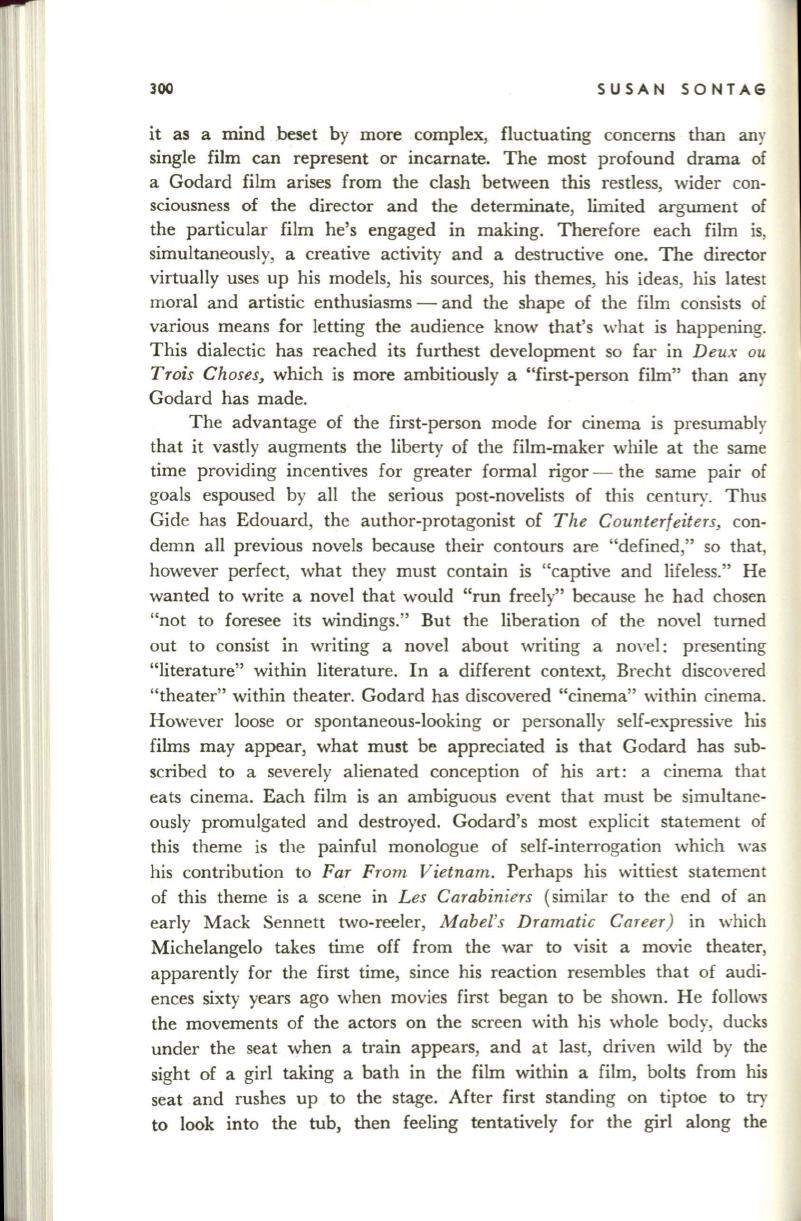
300
SUSAN SONTAG
it as a mind .beset by more .complex, fluctuating concerns than any
single film can represent or incarnate. The most profound drama of
a Godard film arises from the clash between this restless, wider con–
sciousness of the director and the determinate, limited argument of
the particular film he's engaged in making. Therefore each film is,
simultaneously, a creative activity and a destructive one. The director
virtually uses up his models, his sources, his themes, his ideas, his latest
moral and artistic enthusiasms - and the shape of the film consists of
various means for letting the audience know that's what is happening.
This dialectic has reached its furthest development so far in
Deux ou
Trois Chases,
which is more ambitiously a "first-person film" than any
Godard has made.
The advantage of the first-person mode for cinema is presumably
that it vastly augments the liberty of the film-maker while at the same
time providing incentives for greater formal rigor - the same pair of
goals espoused by all the serious post-novelists of this century. Thus
Gide has Edouard, the author-protagonist of
The Counterfeiters,
con–
demn all previous novels because their contours are "defined," so that,
however perfect, what they must contain is "captive and lifeless." He
wanted to write a novel that would "run freely" because he had chosen
"not to foresee its windings." But the liberation of the novel turned
out to consist in writing a novel about writing a novel: presenting
"literature" within literature. In a different context, Brecht discovered
"theater" within theater. Godard has discovered "cinema" within cinema.
However loose or spontaneous-looking or personally self-expressive his
films may appear, what must be appreciated is that Godard has sub–
scribed to a severely alienated conception of his art: a cinema that
eats cinema. Each film is an ambiguous event that must be simultane–
ously promulgated and destroyed. Godard's most explicit statement of
this theme is the painful monologue of self-interrogation which was
his contribution to
Far From Vietnam.
Perhaps his wittiest statement
of this theme is a scene in
Les Carabiniers
(similar to the end of an
early Mack Sennett two-reeler,
Mabel's Dramatic Career)
in which
Michelangelo takes time off from the war to visit a movie theater,
apparently for the first time, since his reaction resembles that of audi–
ences sixty years ago when movies first began to be shown. He follows
the movements of the actors on the screen with his whole body, ducks
under the seat when a train appears, and at last, driven wild by the
sight of a girl taking a bath in the film within a film, bolts from his
seat and rushes up to the stage. After first standing on tiptoe to try
to look into the tub, then feeling tentatively for the girl along the


